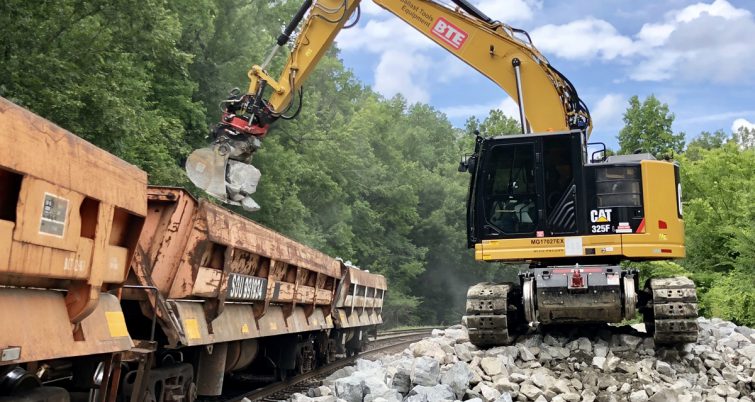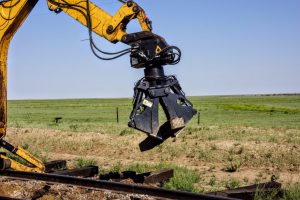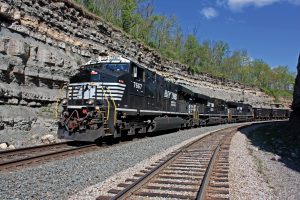Ballast maintenance update: Better, faster ballast
Written by Kyra Senese, Managing Editor
Suppliers and contractors aim to provide railroads with efficient ballast delivery methods and long-lasting solutions. Here’s a look at what’s happening in ballast maintenance in 2019.
Ballast Tools Equipment
This year, the BTE-325 Railroad Modified Hi-Rail Excavator is garnering attention for its versatility and durability, says Matt Weyand, sales engineer.
“The exclusive BTE four-wheel hi-rail system provides power for on-rail ballast maintenance,” Weyand said.
The BTE hi-rail system allows BTE’s hi-rail machines to be used on or off rail with a quick change. The BTE-325 can be rapidly deployed on rail and easily jumps off-track for more versatility or to allow train traffic to pass, the company said.
The Rototilt attachment, with a 360-degree rotation capability and 40-degree tilt, allows operators to profile the ballast in various positions while remaining on the track. Paired with a ditching bucket or one of BTE’s high-performance undercutters, the company describes its BTE-325 as “an indispensable track maintenance workhorse.”
As for recent trends, Weyand said good drainage and ballast maintenance are the top priorities of all railroads. The BTE-325 is intended to effectively and efficiently remove fouled ballast to eliminate mud spots.
“It’s critical; BTE carries a wide array of attachments for ballast maintenance,” he said. “With the BTE Attachment Recognition System, which automatically sets hydraulic flows, pressures and joysticks for attachments, changing attachments is fast and easy for the operator.”
Weyand added that all BTE machines are engineered with a very durable, robust hi-rail system, which is designed to handle long distances traveling on the rail without overheating.
“What sets us apart from our competitors is our superior drive system for traveling on the rail,” he said.
The BTE-325, with a top on-track speed of approximately 22 mph, is meant to quickly reach the jobsite. With BTE’s assortment of attachments, Weyand said the BTE-325 can be used 365 days a year.
Dymax Inc.
2018 was a busy year for DymaxRail in the continued development of ballast maintenance work tools, the company said. Dymax touts the usefulness of its Ballast Blaster, which the company said features an improved automatic chain tensioning system (U.S. Patent No. 9,487,921).
Representatives explained that maintaining constant, perfect tension on the Ballast Blaster’s chain dramatically increases the life of the chain and leads to a longer service life for sprockets, as well. With larger drive motors on all models, Dymax said its performance has increased across the board. DymaxRail Ballast Blasters work with all brands of excavators, so users are not limited to using a single brand or supplier for machines and tools.
“Customers can buy a machine at the best price in the market, and work with DymaxRail to get a Blaster to match the machine,” said Scott Balderson, president of DymaxRail.
Complementing the Ballast Blaster is the DymaxRail Single Motor Ballast Tamper. With a more powerful motor, the company said its tamper outperforms other excavator or backhoe mounted tamping units.
A recent addition to the DymaxRail ballast maintenance lineup is the Hydraulic Clam Cribbing Bucket for backhoe loaders and excavators. The tool allows operators the ability to perform many jobs from a hi-railed position, the company said.

The DymaxRail Hydraulic
Clam Cribbing Bucket is
designed for general cribbing
and, with optional
bolt-on tie claws, removing
old wood ties and inserting
new ones.
Dymax explained that the Clam Cribbing Bucket is ideal for extracting old ties and inserting new ones. Additionally, the company said more than 20 tons of force easily breaks through cemented ballast formation, providing the choice of tie tong scarifier teeth or a standard bolt on cutting edges.
The DymaxRail Hydraulic Clam Cribbing Bucket is truly ballast maintenance simplified. DymaxRail is dedicated to innovation in the rail market. The company is constantly creating new tools to perform important jobs in more productive and cost-effective ways.
Knox Kershaw Inc.
In 2019, Knox Kershaw Inc. (KKI) is introducing CAN based controls for Snow Fighters and Ballast Regulators, according to George Pugh, president and C.O.O. The upgrade is expected to aid in operation, diagnostics and fault monitoring utilizing a 12-inch touch screen monitor.
Pugh said safety parameters will be installed to prevent injuries to personnel and costly damage to the machine. A KSF940 Snow Fighter that incorporates these features will also be on display at the 2019 Railway Interchange in Minneapolis, Minn. This year, KKI is continuing efforts to expand its service and training department to include on-site and in-house training. Pugh said the company now offers parts, service, repair and training on KKI’s equipment in addition to MOW equipment by other manufacturers.
“Our KBR 860 Ballast Regulator is very popular with contractors due to its easy transport from job to job by truck,” Pugh explained. “The KSF 940 Snow Fighters are very popular in locations where railroads have to alternate between working in snow, ballast and vegetation control since this model can be now be purchased with kits to quickly convert it from snow fighter to regulator to brush cutter.”
Additionally, Pugh said the company’s new KRC 70 Ramp Car makes loading, unloading and transporting equipment by rail to job sites an efficient and fluid process.
Recently, Pugh said customers have been expressing a need for improved dust suppression for the health and safety of workers as well as the environment, which he said is why KKI offers dust suppression systems on Knox Kershaw ballast regulators and cribber adzers.
There is always a need for improved safety on MOW machines on the market, and Pugh said one way the company has worked to meet this need is by making improvements to cab entrances and steps around the machines, installing steps on a slope for better visibility when entering and exiting, using a new grating on steps to allow for better grip and drainage, and improving lighting at the cab entrance.
Another topic of interest in the MOW field has been the desire for more automated work components on equipment, Pugh said.
“Technology is constantly changing, allowing us to improve the way we operate and do tasks with more efficiency and precision,” he explained. One major technological advancement Knox Kershaw Inc. has reportedly made in its machines has been the incorporation of its CAN system with a touch screen monitor to make operating the machines easier and more automated.
“We are always working on new products to expand our product line as we continue to improve our offerings,” Pugh said.
Loram Maintenance of Way, Inc.
Loram says the company is continuing to advance the deployment of Ground Penetrating Radar as an on-board system for rail-bound vehicles, said Brandon Riddering, the company’s director of Marketing.
Riddering explained that Loram’s onboard GPR systems are installed directly onto the railroad’s measurement vehicle (geometry car) using special “electromagnetic shielding” to allow the antennas to be placed underneath rail-bound vehicles.
The railroad’s onboard technicians also have the capability of collecting information on the ballast and roadbed condition with minimal onboard assistance at a speed of more than 100 mph, Riddering said.
By having GPR as a part of the routine, semi-autonomous measurement aboard their geometry cars, Loram said it aims to provide a lower-cost method of collecting valuable information as compared to traditional hirail-based approaches.
Loram has also reportedly spent considerable time developing its geotechnical services.
“Our customers continue to have the need to do more or better with the same or less resources,” Riddering said. “Through the use of Ground Penetrating Radar (GPR) and our proprietary software, we are able to work with our customers to help determine how to allocate their track windows and resources to maximize their ballast and drainage investment returns.”
Loram currently works with all Class 1s, shortlines and many transit and commuter railroads, he added.
“The more knowledge the railroads have regarding the state of their ballast and drainage quality, the better they are able to allocate their resources to maximize their investment returns,” Riddering stated.
Montana Hydraulics
Currently, Montana Hydraulics is putting the finishing touches on two new products: a new design for covered ballast hoppers that the company says will help mitigate the hassles of frozen ballast, as well as being environmentally friendly, and safer than the other covering systems that our field crews have worked with.
Della Ehlke, co-owner of Montana Hydraulics, explained that covered cars are also substantially more fuel efficient that open topped cars.
“We also have developed a ballast car gate system designed for more rugged conditions, which should lead to longer gate life as well as more clearance between car and rail,” Ehlke said.
Prototypes are ongoing and in various stages of development with a focus on high-cycle use in everyday service, she said, adding that the company’s ultimate goal remains as saving railroads money by having ballast cars that are operational when needed.
“Finalizing these two very important prototypes and the addition of state of the art equipment that allows more efficient shop production of our railroad products has kept us busy this past year,” Ehlke said. “We believe it was the best use of our resources given the current push to keep ballast cars operational.”
Montana Hydraulics has also added an additional shop manufacturing facility, with plenty of room for expansion. The company touted its the experience of its crew of technicians and their ability to perform maintenance work on ballast cars.
In 2019, the company will mark the 21st consecutive year that Montana Hydraulics has performed field service work for a major Class 1 railroad.
“In addition to our field service for them, we have also designed and built several custom applications for the enhancement of their ballast car operations, some were installed in the field by our technicians, our center mounted bi directional plow was also included in several new ballast car builds,” Ehlke said.
The company also provides ballast car service to a couple of regional shortlines and has performed ballast car retrofits for such clients. Montana Hydraulics will be demo-ing its gate system on one of the shortlines’ballast cars later this spring after the weather smoothes out.
“Our gate is of particular interest to them due to their desire to economically convey rock from under the car to stockpiles,” Ehlke said.
A returning trend identified by Montana Hydraulics is for contractors’ expectations to remain more involved in expanded railroad safety training and programs. The attention to “real” cost to railroads of non-functioning ballast cars has intensified recently, as well, Ehlke said.
“Our customers keep asking for innovative solutions to enhance their operations, improve on their safety initiatives, help lower their cost basis and lessen environmental impact,” Ehlke said.
Throughout the winter months, Ehlke said frozen ballast has continued to create issues, and the demand for ballast cars has continued in most areas despite the weather.
A main focus for Montana Hydraulics in the year ahead will be getting information out about the company’s ballast car cover system and its new ballast gate.
“We hope to be at least part of the solution for lost revenue due non-operational ballast cars as a result of frozen ballast,” Ehlke said. “We plan to be prepared to expand our contracted field service work on ballast car maintenance.”
The company notes that it also recently completed its ISO 9000: 2015 quality certification audit. Additionally, Montana Hydraulics’ revamped safety program and the team’s focus on safety has produced results.
“Our ballast field crew has had 1,438 days without a lost time accident and our shops have had 2,756 days without a lost time accident,” Ehlke explained, as of press time.
Plasser American
Plasser offers several products to help customers achieve the required ballast results. The company said clean ballast is extremely important to maintain track geometry, and Plasser offers several machines for cleaning ballast. The company notes the workhorse of its fleet of machines is the RM80, which can undercut and clean plain track, as well as switches. Additionally, Plasser offers high-capacity double screening units, such as the RM2003 and the RM802 High Speed Undercutter-Cleaner.
Plasser also offers various single and double-shaker shoulder cleaners, which the company said utilize endless paddle type excavation cutter chains and is capable of adjusting the cutting width from 24 inches to 60 inches “on the fly.” The cutting angle can also be adjusted to provide for the proper drainage.
In instances when track quality cannot be maintained by normal ballast cleaning, due to weak subgrade or continuous fouling from the subgrade, Plasser says a subgrade renewal machine can be used to correct the problem. Subgrade renewal machines remove the ballast layer and the sub-ballast layer, replacing it with a formation protection layer and a layer of ballast in one pass.
All of the work is performed without physically removing the track, allowing for shorter track outages. Plasser also offers several versions of these machines, such as the AHM 800 R Formation Rehabilitation Machine. The BDS100/200 Ballast Distribution System continues to be the ideal machine to accompany the high-speed 09-3X tampers or multiple tampers working together, Plasser explained.
The machines are equipped with plows to profile the ballast, hopper and conveyors to distribute ballast as needed and double brooms to sweep up and store excess ballast and for final track dressing. MFS Hopper/ Conveyor cars can be added for additional ballast storage; all work is performed in a “one pass” operation.
The BDS system may also be operated on its own to distribute ballast and re-profile ballast profiles as needed. Excessive ballast can be picked up and unloaded where needed, such as the high side of curves, switches and road crossings as needed.
Plasser’s PBR2005 Ballast Profiling machine has the ability to plow, profile and broom in one pass. The machine is also available with an optional double broom. The PBR2005DB is ideally suited to work behind two-tie tampers where it can easily keep up with the tamper in a ‘one pass’ operation.
“The unique design of the shoulder plows allow the machine to reach out and pull in ballast, which was previously beyond the reach of conventional ballast regulators,” Plasser said.





